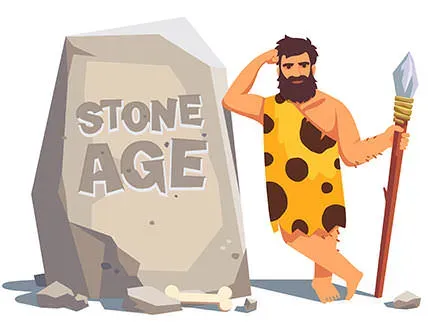 Evidence of the use of precious stones in early times as amulets and talismans has been found in many ancient records. Many scholars assume that the belief in the magical uses of these stones gave rise to their use as objects of personal jewelry. It's difficult to prove this theory because even the oldest books written on the subject were written many centuries after the first uses of precious stones. Thousands of years went by before people could attain the level of civilization necessary for the production of even the simplest form of writing.
Evidence of the use of precious stones in early times as amulets and talismans has been found in many ancient records. Many scholars assume that the belief in the magical uses of these stones gave rise to their use as objects of personal jewelry. It's difficult to prove this theory because even the oldest books written on the subject were written many centuries after the first uses of precious stones. Thousands of years went by before people could attain the level of civilization necessary for the production of even the simplest form of writing.
 In the case of stones we can conclude that the stones that were supposed to be good or evil were selected because of their natural form, which suggested the shape of an animal or a part of the human body. On the other hand, wearing precious stones is more likely to have been due to the attraction of bright colors by the wearer and the desire to display this distinguishing mark that would bring them attention and admiration. This theory exists within the animal kingdom and has served as a foundation for the premise of natural selection.
In the case of stones we can conclude that the stones that were supposed to be good or evil were selected because of their natural form, which suggested the shape of an animal or a part of the human body. On the other hand, wearing precious stones is more likely to have been due to the attraction of bright colors by the wearer and the desire to display this distinguishing mark that would bring them attention and admiration. This theory exists within the animal kingdom and has served as a foundation for the premise of natural selection.
 It seems likely that this is the real explanation of the motive for the love of precious stones. Since the stones are motionless, they cannot have impressed the mind of primitive people with the idea that they were alive. The stones were not imposing as a mass, and their form did not look like any primitive shape. This idea leads us to believe that what attracted the primitive man to these stones was their brilliance and color. The effect these qualities had upon the visual sense of the primitive man compares to the effect the stones produce upon infants. A baby is not afraid of a small, brightly colored object and will eagerly put out its hand to take, hold, and look at it. Because the stone is easy to handle, there is nothing to suggest lurking danger and nothing to interfere with the pleasurable sensation that is aroused by the beautiful play of color. In the baby's na�ve admiration of what is brilliant and colored, the baby represents the mental attitude of the primitive man.
It seems likely that this is the real explanation of the motive for the love of precious stones. Since the stones are motionless, they cannot have impressed the mind of primitive people with the idea that they were alive. The stones were not imposing as a mass, and their form did not look like any primitive shape. This idea leads us to believe that what attracted the primitive man to these stones was their brilliance and color. The effect these qualities had upon the visual sense of the primitive man compares to the effect the stones produce upon infants. A baby is not afraid of a small, brightly colored object and will eagerly put out its hand to take, hold, and look at it. Because the stone is easy to handle, there is nothing to suggest lurking danger and nothing to interfere with the pleasurable sensation that is aroused by the beautiful play of color. In the baby's na�ve admiration of what is brilliant and colored, the baby represents the mental attitude of the primitive man.
 The first objects in history that used for personal decoration were goods that could easily be strung or bound together- for example, soft shells or shiny seeds. Harder gemstones were then only collected, as no one had the tools as of yet, to make holes in them.
The first objects in history that used for personal decoration were goods that could easily be strung or bound together- for example, soft shells or shiny seeds. Harder gemstones were then only collected, as no one had the tools as of yet, to make holes in them.
 Once these objects were worn, there was a tendency to attribute events to their powers. Because of this, a belief in their power arose- a belief that the stones were the dwelling places of powerful spirits. For these reasons, man's first, instinctive appreciation of precious stones was based on their powers, and it has taken centuries of enlightenment to bring man's love of gems back to a simple adoration of their beauty. Even today, with the opal, for example, we see the power of superstition alive and kicking. Some people are afraid of the myth that wearing an opal attracts bad luck. However until three of four centuries ago, the opal was thoughts to combine all the virtues of colorful gemstones together, colors which unite in the opals' sparkling light.
Once these objects were worn, there was a tendency to attribute events to their powers. Because of this, a belief in their power arose- a belief that the stones were the dwelling places of powerful spirits. For these reasons, man's first, instinctive appreciation of precious stones was based on their powers, and it has taken centuries of enlightenment to bring man's love of gems back to a simple adoration of their beauty. Even today, with the opal, for example, we see the power of superstition alive and kicking. Some people are afraid of the myth that wearing an opal attracts bad luck. However until three of four centuries ago, the opal was thoughts to combine all the virtues of colorful gemstones together, colors which unite in the opals' sparkling light.
 When it comes to man's love of bright and colorful objects, we see that the first primitive man may have started to collect stones because of birds. Specifically, there is a bird called the Chlamydera from Australia, which is similar to a raven. After constructing green, leafy orchards for themselves, these birds arranged the floors full of varied pebbles, organized to look like a mosaic pavement. At the entrance of the birds' orchards, were heaps of pieces of bone, feathers, shells, and stones, which were often carried from a great distance. This amount of effort is clear evidence that there was something special about these particular stones, that made the birds go through the effort of bringing them from so far away. The choice of these specific stones was not random. It is strange that anyone would dismiss this love of beautiful brightly colored objects because of their supposed talismanic qualities.
When it comes to man's love of bright and colorful objects, we see that the first primitive man may have started to collect stones because of birds. Specifically, there is a bird called the Chlamydera from Australia, which is similar to a raven. After constructing green, leafy orchards for themselves, these birds arranged the floors full of varied pebbles, organized to look like a mosaic pavement. At the entrance of the birds' orchards, were heaps of pieces of bone, feathers, shells, and stones, which were often carried from a great distance. This amount of effort is clear evidence that there was something special about these particular stones, that made the birds go through the effort of bringing them from so far away. The choice of these specific stones was not random. It is strange that anyone would dismiss this love of beautiful brightly colored objects because of their supposed talismanic qualities.
 Oddly, seals can back up the notion that brilliant, colored stones were first collected by men because of their beauty. The reason for this is that seals swallow stones and take careful consideration of which stones to eat. Observers in fishing areas have witnessed this phenomenon and think that the pebbles of
Oddly, seals can back up the notion that brilliant, colored stones were first collected by men because of their beauty. The reason for this is that seals swallow stones and take careful consideration of which stones to eat. Observers in fishing areas have witnessed this phenomenon and think that the pebbles of ![]() chalcedony and serpentine they find were brought there by seals.
chalcedony and serpentine they find were brought there by seals.
 The word "amulet"" derived from the Arabic word ""hamalat,"" meaning something which is suspended or worn. Arab scholars, however, do not accept this word, and it is really probably of Latin origin, even though no proof of this is found in etymology. Pliny's use of the word ""amuletum"" shows that the word did not always mean an object that was suspended from a person, though later, this is what the word came to mean. The old etymology given by Varro (118-29BC) derived ""amuletum"" from the verb ""amoliri,"" which means ""to remove"" or ""to drive away."" This meaning may not be in agreement with modern philology, but still, its meaning has something to do with the meaning we know today- that the amulet is something worn to keep away or remove any kind of danger. The word ""talisman"" comes from the Arabic ""tilsam,"" a word derived from Greek, to signify an initiation or wizardry."
The word "amulet"" derived from the Arabic word ""hamalat,"" meaning something which is suspended or worn. Arab scholars, however, do not accept this word, and it is really probably of Latin origin, even though no proof of this is found in etymology. Pliny's use of the word ""amuletum"" shows that the word did not always mean an object that was suspended from a person, though later, this is what the word came to mean. The old etymology given by Varro (118-29BC) derived ""amuletum"" from the verb ""amoliri,"" which means ""to remove"" or ""to drive away."" This meaning may not be in agreement with modern philology, but still, its meaning has something to do with the meaning we know today- that the amulet is something worn to keep away or remove any kind of danger. The word ""talisman"" comes from the Arabic ""tilsam,"" a word derived from Greek, to signify an initiation or wizardry."
 In the early part of the Stone Age, there is no evidence of idols; the art of this period was utterly profane. In later years during the Stone Age, however, the majority of art revolved around religion. This theme evidently came from the conception that every image of a living object absorbs some part of the essence of the object itself. This belief, while primitive, still assumes a certain degree of development and applies mostly to the stunning amulets primitive man crafted.
In the early part of the Stone Age, there is no evidence of idols; the art of this period was utterly profane. In later years during the Stone Age, however, the majority of art revolved around religion. This theme evidently came from the conception that every image of a living object absorbs some part of the essence of the object itself. This belief, while primitive, still assumes a certain degree of development and applies mostly to the stunning amulets primitive man crafted.
A strange talisman from Houailou, New Calcedonia, is in the collection of Signor Giglioli. The stone bears a striking resemblance to the human form. We, therefore, can understand why this stone was thought to be the abode of a spirit. It is easy to understand why people looked at this object as the dwelling of a spirit; similar strange natural formations were regarded with much superstitious awe by people who were a lot more civilized than the New Caledonia Natives.
 From the 17th Century to the Middle Ages, the talismanic virtues of precious stones were presumed to be true by virtually everybody- by the upper class and lower class, by princes and peasants, and by the educated and non-educated. Skepticism did, however, exist for some people. The court jester of Emperor Charles V. is known for his excellent answer to the question, "What is the property of the
From the 17th Century to the Middle Ages, the talismanic virtues of precious stones were presumed to be true by virtually everybody- by the upper class and lower class, by princes and peasants, and by the educated and non-educated. Skepticism did, however, exist for some people. The court jester of Emperor Charles V. is known for his excellent answer to the question, "What is the property of the ![]() turquoise? ""If you should happen to fall from a high tower whilst you were wearing a turquoise on your finger, the turquoise would remain unbroken,"" he replied."
turquoise? ""If you should happen to fall from a high tower whilst you were wearing a turquoise on your finger, the turquoise would remain unbroken,"" he replied."
 Precious stones and diamonds were thought to be the source of sin and sorrow in the East. A Persian legend of the origin of these stones explains this notion. In the legend, God created the world with no useless things such as silver, gold, diamonds or precious stones. However, Satan, always eager to bring evil to mankind, watched carefully to see what appealed to the appetites and passions of man. He noted that Eve loved the beautiful colored flowers in the Garden of Eden, so he therefore imitated the flower's colors out of the earth, producing precious stones and diamonds. After much time, these stones appealed so much to the greed and covetousness of people, that they have been the cause of much evil and crime.
Precious stones and diamonds were thought to be the source of sin and sorrow in the East. A Persian legend of the origin of these stones explains this notion. In the legend, God created the world with no useless things such as silver, gold, diamonds or precious stones. However, Satan, always eager to bring evil to mankind, watched carefully to see what appealed to the appetites and passions of man. He noted that Eve loved the beautiful colored flowers in the Garden of Eden, so he therefore imitated the flower's colors out of the earth, producing precious stones and diamonds. After much time, these stones appealed so much to the greed and covetousness of people, that they have been the cause of much evil and crime.
 In the present time, if people were to admit their honest beliefs, we would find that we have just as much faith in the power of gemstones as people did in the past. However people are ashamed of their fondness for these stones and do not recognize that behind all of the superstition that exists, there is a deeper meaning in these stones than what we first perceive. People become happy when they learn that many of the soldiers in the Austro-Prussian War of 1886 carried amulets and that the great French soldier Marshal Canrobert wore an amulet in the Crimean campaign. During the Russo-Japanese War, the Russian army was given various objects that had been blessed by a priest. These objects were pictures, amulets, or religious medals.
In the present time, if people were to admit their honest beliefs, we would find that we have just as much faith in the power of gemstones as people did in the past. However people are ashamed of their fondness for these stones and do not recognize that behind all of the superstition that exists, there is a deeper meaning in these stones than what we first perceive. People become happy when they learn that many of the soldiers in the Austro-Prussian War of 1886 carried amulets and that the great French soldier Marshal Canrobert wore an amulet in the Crimean campaign. During the Russo-Japanese War, the Russian army was given various objects that had been blessed by a priest. These objects were pictures, amulets, or religious medals.
 What subtle sense is it that makes some women endow their gemstones with a particular individuality and sensitivity? An idea that leads them to believe that these inanimate objects partake in human emotion? A French writer, Madame Catulle Mendes, expresses this by saying that she makes it a purpose to wear as many rings at the same time as she possibly can, because her gems feel insulted when she leaves them unworn. She writes, "I have a
What subtle sense is it that makes some women endow their gemstones with a particular individuality and sensitivity? An idea that leads them to believe that these inanimate objects partake in human emotion? A French writer, Madame Catulle Mendes, expresses this by saying that she makes it a purpose to wear as many rings at the same time as she possibly can, because her gems feel insulted when she leaves them unworn. She writes, "I have a ![]() ruby which grows dull, two turquoises which become pale as death, aquamarines which look like siren's eyes filled with tears, when I forget them for too long. How sad I should feel if precious stones did not love to rest upon me!"""
ruby which grows dull, two turquoises which become pale as death, aquamarines which look like siren's eyes filled with tears, when I forget them for too long. How sad I should feel if precious stones did not love to rest upon me!"""
 In 1909, a beautiful and curious object was found in the opal fields of Australia. It was a reptilian skeleton that looked like a small snake and had been opalized by natural processes. In this case, nature produced an impressive and beautiful thing exceeding any object ever created by man. In ancient times, this skeleton would have been valued at an enormous sum, because the figure of a serpent was a favorite in medical science. Even in present times, this strange object would undoubtedly be sought after by collectors, and would appeal to those interested in occult science, as well as to those who appreciate the poetic and mystic significance of sign, symbol and form.
In 1909, a beautiful and curious object was found in the opal fields of Australia. It was a reptilian skeleton that looked like a small snake and had been opalized by natural processes. In this case, nature produced an impressive and beautiful thing exceeding any object ever created by man. In ancient times, this skeleton would have been valued at an enormous sum, because the figure of a serpent was a favorite in medical science. Even in present times, this strange object would undoubtedly be sought after by collectors, and would appeal to those interested in occult science, as well as to those who appreciate the poetic and mystic significance of sign, symbol and form.
 It is impossible to over-estimate the effect of color in determining the influence of gems upon the health and fortunes of the wearers. When we look at the beautiful play of light emitted by a fine
It is impossible to over-estimate the effect of color in determining the influence of gems upon the health and fortunes of the wearers. When we look at the beautiful play of light emitted by a fine ![]() ruby or
ruby or ![]() sapphire, its beauty has an effect on us. In earlier times, however, when scientific ideas were not prevalent, many other considerations were combined that gave significant meaning to these brilliant gems. As rare and expensive as they were, the gemstones supposedly possessed powers and were thought to be the dwellings of spirits, sometimes benevolent and sometimes malevolent, but always powerful enough to influence human destiny. Along with this was the appreciation of the qualities of the individual rays of light they possessed, and modern science, far from forgetting about these ideas, has seemed to find a good reason for them.
sapphire, its beauty has an effect on us. In earlier times, however, when scientific ideas were not prevalent, many other considerations were combined that gave significant meaning to these brilliant gems. As rare and expensive as they were, the gemstones supposedly possessed powers and were thought to be the dwellings of spirits, sometimes benevolent and sometimes malevolent, but always powerful enough to influence human destiny. Along with this was the appreciation of the qualities of the individual rays of light they possessed, and modern science, far from forgetting about these ideas, has seemed to find a good reason for them.
 The red
The red ![]() ruby was always associated with passion. This notion was scientifically proven by spectrum analysis, as the red rays are heat-giving and, therefore, feel like they give life. However in regards to color, this was not the only source of these primitive ideas. The therapeutic effect was often sought and found in some fancied analogy between the color of the gem and the character of the sickness that needed to be cured. For example, yellow stones were used to cure cases of jaundice. Red stones were used to check the flow of blood. The bloodstone was prescribed for this purpose, and supposedly by its mere touch, it could stop acute hemorrhages. For sicknesses of the eyes, the color green was prescribed. Emerald and other green stones were used for this purpose. The pure and colorless, white, yet brilliant stones were thought to connect with the moon. The
ruby was always associated with passion. This notion was scientifically proven by spectrum analysis, as the red rays are heat-giving and, therefore, feel like they give life. However in regards to color, this was not the only source of these primitive ideas. The therapeutic effect was often sought and found in some fancied analogy between the color of the gem and the character of the sickness that needed to be cured. For example, yellow stones were used to cure cases of jaundice. Red stones were used to check the flow of blood. The bloodstone was prescribed for this purpose, and supposedly by its mere touch, it could stop acute hemorrhages. For sicknesses of the eyes, the color green was prescribed. Emerald and other green stones were used for this purpose. The pure and colorless, white, yet brilliant stones were thought to connect with the moon. The ![]() diamond, however, because of its superiority in brilliance and value, was believed to be the gemstone of the sun.
diamond, however, because of its superiority in brilliance and value, was believed to be the gemstone of the sun.
 All gems that were thought to have a connection with the moon took on a mysterious character. Lighting up the dark sky, when evil spirits were aroused, the moon was sometimes regarded as threatening. At other times, the moon was thought to have the power to conjure these evil spirits and scare them away into the darkness.
All gems that were thought to have a connection with the moon took on a mysterious character. Lighting up the dark sky, when evil spirits were aroused, the moon was sometimes regarded as threatening. At other times, the moon was thought to have the power to conjure these evil spirits and scare them away into the darkness.
 The symbolic significance of the colors of precious stones was studied at considerable length by Giacinto Gimma, who gathered together a great quantity of material on the subject. For each color, Gimma wrote about what it meant to wear such a color, which gemstone represented each color, which day of the week corresponded to the color, and which animal represented it.
The symbolic significance of the colors of precious stones was studied at considerable length by Giacinto Gimma, who gathered together a great quantity of material on the subject. For each color, Gimma wrote about what it meant to wear such a color, which gemstone represented each color, which day of the week corresponded to the color, and which animal represented it.
 In his writings, he stated that yellow worn by a man, denoted secrecy, and was appropriate for the silent lover. Yellow when worn by a woman, however, indicated generosity. Golden yellow was the symbol of the sun and Sunday. The yellow stone was the chrysolite or the yellow jacinth. The animal connected with yellow was the lion, associated with the astrological sign, Leo. Yellow also represented adolescence in a person's life. Roman matrons used to cover their head with a yellow veil to show their hope for offspring and happiness. To wear yellow clothing was a sign of grandeur and nobility.
In his writings, he stated that yellow worn by a man, denoted secrecy, and was appropriate for the silent lover. Yellow when worn by a woman, however, indicated generosity. Golden yellow was the symbol of the sun and Sunday. The yellow stone was the chrysolite or the yellow jacinth. The animal connected with yellow was the lion, associated with the astrological sign, Leo. Yellow also represented adolescence in a person's life. Roman matrons used to cover their head with a yellow veil to show their hope for offspring and happiness. To wear yellow clothing was a sign of grandeur and nobility.
 The color white when worn by men, symbolized religion, friendship, and integrity. For women, wearing white signified graciousness, purity, and contemplation. White was associated with the moon and with Monday and was represented by the pearl. The mystic number linked to white was seven, and the color represented the infancy stage of life. In ancient times, white was a sign of mourning and sadness. Greek matrons wore white upon the death of their husbands and in Italy, widows wore white bands around their heads.
The color white when worn by men, symbolized religion, friendship, and integrity. For women, wearing white signified graciousness, purity, and contemplation. White was associated with the moon and with Monday and was represented by the pearl. The mystic number linked to white was seven, and the color represented the infancy stage of life. In ancient times, white was a sign of mourning and sadness. Greek matrons wore white upon the death of their husbands and in Italy, widows wore white bands around their heads.
 The color red, when worn by a man, indicated power, nobility, lordship, and vengeance. When worn by a woman, red represented purpose, and pride. The color red represented the planet Mars and Tuesday. Ruby was the gemstone used to represent red. Oddly, the lynx was the animal which represented red. Red symbolized full manhood, as the color is so vivid. Its number was nine. The Ancients covered those who died in battle with red, and the Italian code of criminal laws, known as "Digesto Nuovo,"" was bound in red, to signify that a bloody death awaited thieves and murderers."
The color red, when worn by a man, indicated power, nobility, lordship, and vengeance. When worn by a woman, red represented purpose, and pride. The color red represented the planet Mars and Tuesday. Ruby was the gemstone used to represent red. Oddly, the lynx was the animal which represented red. Red symbolized full manhood, as the color is so vivid. Its number was nine. The Ancients covered those who died in battle with red, and the Italian code of criminal laws, known as "Digesto Nuovo,"" was bound in red, to signify that a bloody death awaited thieves and murderers."
 The color blue on a man signified wisdom and high, selfless thoughts. On a woman, wearing blue represented jealousy, vigilance, and politeness. Blue represented Friday and Venus, and
The color blue on a man signified wisdom and high, selfless thoughts. On a woman, wearing blue represented jealousy, vigilance, and politeness. Blue represented Friday and Venus, and ![]() sapphire was the stone in which this color appeared in all its beauty. Blue was a symbol of the age of childhood; the color was associated with the number six, and was represented by the goat. Studies of science, the heavens, and stellar influences were all typified by blue.
sapphire was the stone in which this color appeared in all its beauty. Blue was a symbol of the age of childhood; the color was associated with the number six, and was represented by the goat. Studies of science, the heavens, and stellar influences were all typified by blue.
 For men, wearing green signified joyousness, hope, and the decline of friendships. For women, wearing green symbolized unfound ambition, childish delight, and change. The early green of spring might be regarded as at once a symbol of hope, but also eventual disappointment, because spring always naturally must pass away. Mercury and Wednesday, the day of Mercury, were both typified by green, and the sly fox was selected as the animal. Emerald was used as the typical green stone, youth is the age of man represented by the color, and five is the magic number associated with it. In ancient times, green was used for those who died in the flower of youth. An
For men, wearing green signified joyousness, hope, and the decline of friendships. For women, wearing green symbolized unfound ambition, childish delight, and change. The early green of spring might be regarded as at once a symbol of hope, but also eventual disappointment, because spring always naturally must pass away. Mercury and Wednesday, the day of Mercury, were both typified by green, and the sly fox was selected as the animal. Emerald was used as the typical green stone, youth is the age of man represented by the color, and five is the magic number associated with it. In ancient times, green was used for those who died in the flower of youth. An ![]() emerald was sometimes placed on the index-finger of the corpse. In Italy, graves of young virgins and children were covered with green branches.
emerald was sometimes placed on the index-finger of the corpse. In Italy, graves of young virgins and children were covered with green branches.
 The color black, when worn by a man, meant force, dependability, wisdom, and patience. For young women, wearing black signified fickleness and foolishness, but for married women black meant constant love and perseverance. Black was the color for the planet Saturn and Saturday. Strangely, the
The color black, when worn by a man, meant force, dependability, wisdom, and patience. For young women, wearing black signified fickleness and foolishness, but for married women black meant constant love and perseverance. Black was the color for the planet Saturn and Saturday. Strangely, the ![]() diamond was chosen to represent black, and the hog was the color's animal. Black was a mourning color and signified weakness and decay. The number eight was supposed to have some affinity with black.
diamond was chosen to represent black, and the hog was the color's animal. Black was a mourning color and signified weakness and decay. The number eight was supposed to have some affinity with black.
 For a man, wearing the color violet denoted sober judgment and force. For women, the color indicated intelligent thoughts and pure love. Violet was the color of the planet Jupiter and Thursday. As with blue, the
For a man, wearing the color violet denoted sober judgment and force. For women, the color indicated intelligent thoughts and pure love. Violet was the color of the planet Jupiter and Thursday. As with blue, the ![]() sapphire represented violet most attractively. The bull was the animal represented by violet, probably because of its mythological connection with Jupiter. Violet was associated with the number three and symbolized the last stage of life.
sapphire represented violet most attractively. The bull was the animal represented by violet, probably because of its mythological connection with Jupiter. Violet was associated with the number three and symbolized the last stage of life.
 The influence of color on the nervous system was studied by some of the leading authorities on hypnotism. Dr. Paul Ferez found that red light is stimulating, and blue light is calming and suggested that hypnotists should have two rooms for their reception. In one, the curtains, chair coverings, wallpaper, etc, should be red. In the other room, everything should be all violet-blue. Patients suffering from a lack of willpower or depression should be brought to the red room and those who are prey to over-excitability, led to the blue room. Dr. Ferez wrote about the sedative qualities of the violet-blue color which can be helpful in inducing a hypnotic state. For hypnotizing someone, he recommended a violet blue disc, which was to be rotated rapidly before the eyes of the patient, the movement serving to attract and hold the patient's gaze better than any mobile object would.
The influence of color on the nervous system was studied by some of the leading authorities on hypnotism. Dr. Paul Ferez found that red light is stimulating, and blue light is calming and suggested that hypnotists should have two rooms for their reception. In one, the curtains, chair coverings, wallpaper, etc, should be red. In the other room, everything should be all violet-blue. Patients suffering from a lack of willpower or depression should be brought to the red room and those who are prey to over-excitability, led to the blue room. Dr. Ferez wrote about the sedative qualities of the violet-blue color which can be helpful in inducing a hypnotic state. For hypnotizing someone, he recommended a violet blue disc, which was to be rotated rapidly before the eyes of the patient, the movement serving to attract and hold the patient's gaze better than any mobile object would.
 Red stones such a garnets and rubies whose color suggests blood, were not only believed to confer invulnerability, but some Asiatic tribes used garnets as bullets, upon the contrary principle that this blood-covered stone would inflict a more deadly wound than a regular bullet. In 1892, on the Kashmir frontier, the rebellious Hanzas used these
Red stones such a garnets and rubies whose color suggests blood, were not only believed to confer invulnerability, but some Asiatic tribes used garnets as bullets, upon the contrary principle that this blood-covered stone would inflict a more deadly wound than a regular bullet. In 1892, on the Kashmir frontier, the rebellious Hanzas used these ![]() garnet bullets during their fights with the British troops, and many of these precious missiles were preserved as curiosities.
garnet bullets during their fights with the British troops, and many of these precious missiles were preserved as curiosities.
 In his "Colloquy on Pilgrimages,"" Erasmus makes one of the speakers ask, ""Dost though not see how the artificer nature delights to represent all things by colors and forms, but more especially in gems?"" Erasmus then discusses the various images of natural objects in stones: ""In the pyrope appeared living fire; rock crystal preserved the form and coldness of the hailstone even if cast into the fire. In the
In his "Colloquy on Pilgrimages,"" Erasmus makes one of the speakers ask, ""Dost though not see how the artificer nature delights to represent all things by colors and forms, but more especially in gems?"" Erasmus then discusses the various images of natural objects in stones: ""In the pyrope appeared living fire; rock crystal preserved the form and coldness of the hailstone even if cast into the fire. In the ![]() emerald, one could see the deep and translucent waves of the sea; the carcinia imitated the form of crabs; the echites, of vipers; the hieracites, of hawks, the geranites, of cranes. The aetites offered the image of an eagle with a white tail; the tas had the form of a peacock; the chelonites of an asp, while the mymecites bore within the figure of an ant."""
emerald, one could see the deep and translucent waves of the sea; the carcinia imitated the form of crabs; the echites, of vipers; the hieracites, of hawks, the geranites, of cranes. The aetites offered the image of an eagle with a white tail; the tas had the form of a peacock; the chelonites of an asp, while the mymecites bore within the figure of an ant."""
 Erasmus created Greek names for these stones that signified their real or supposed resemblance to natural objects. Many of these objects were fossils, preserving the form of a living organism; a few were entirely fabulous; still others owed their fancied therapeutic virtues, to a legend or myth, as in the case of the aetites (eagle stone) said to be found in the eagle's nest. Evidently this was a
Erasmus created Greek names for these stones that signified their real or supposed resemblance to natural objects. Many of these objects were fossils, preserving the form of a living organism; a few were entirely fabulous; still others owed their fancied therapeutic virtues, to a legend or myth, as in the case of the aetites (eagle stone) said to be found in the eagle's nest. Evidently this was a ![]() quartz pebble.
quartz pebble.
 A mythological story from Babylon tells of the solar deity Ninib who cast a blessing or a curse on various stones, therefore determining the fate of them. For example, the dolomite was blessed and declared to be a proper material with which to carve the statues of kings, while a substance called the elu stone was cursed, proclaimed to be unfit for working, and doomed to disintegration. Alabaster was favored by the god, but
A mythological story from Babylon tells of the solar deity Ninib who cast a blessing or a curse on various stones, therefore determining the fate of them. For example, the dolomite was blessed and declared to be a proper material with which to carve the statues of kings, while a substance called the elu stone was cursed, proclaimed to be unfit for working, and doomed to disintegration. Alabaster was favored by the god, but ![]() chalcedony aroused his anger and was condemned.
chalcedony aroused his anger and was condemned.
 In these inscriptions, there is also mention of "the aan rame"" and ""the aban la rame,"" or ""the Stone of Love"" and ""the Stone of Hate."" Evidently, these stones were believed to excite one or other of these contradictory passions in the heart of the wearers, and they may both can be compared with the stones of memory and forgetfulness in the ""Gesta Romanorum."""
In these inscriptions, there is also mention of "the aan rame"" and ""the aban la rame,"" or ""the Stone of Love"" and ""the Stone of Hate."" Evidently, these stones were believed to excite one or other of these contradictory passions in the heart of the wearers, and they may both can be compared with the stones of memory and forgetfulness in the ""Gesta Romanorum."""